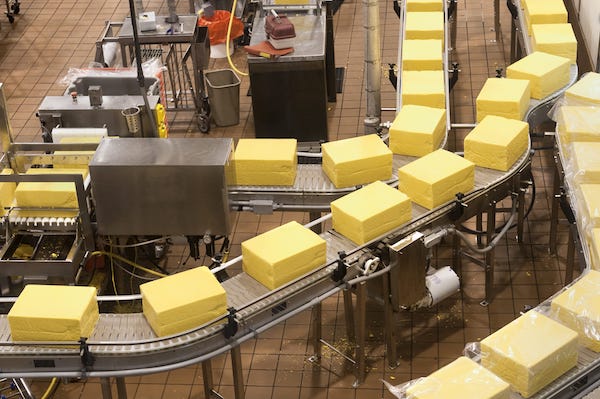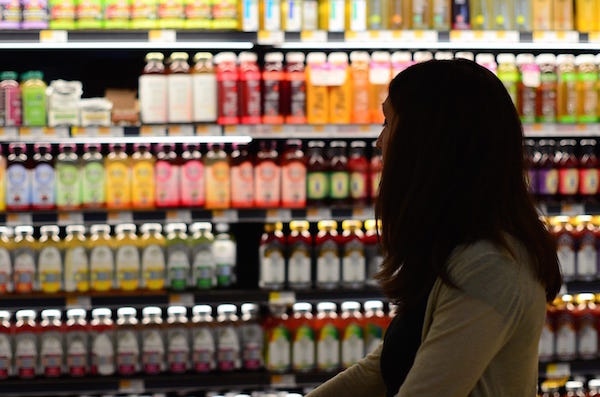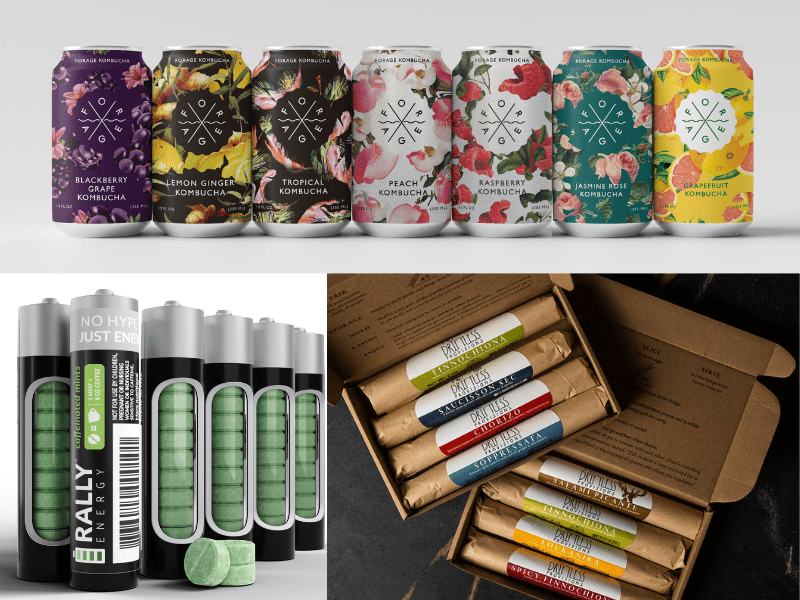It can be a big leap to think about producing larger quantities of food when entrepreneurs are used to home production or commercial kitchens, where the batch size and financial outlay are relatively small, and operational processes are simple. However, if food businesses are considering going into wide-scale distribution in grocery stores and they want to be profitable (hopefully, they do!), they will need the capacity to produce their food at scale.
The inevitable question these entrepreneurs face then is “should I manufacture food in-house or use a co-packer?” This question can be difficult to navigate for new food producers, especially because there is not a hard and fast answer. The food entrepreneur’s business model, stage of business, financing capacity (i.e. how well they can raise money) and the availability of co-packing capacity for their specific needs all make a difference in deciding how to answer that question.
For some context, it is important to understand that co-packers, like all manufacturing businesses, make money when their facilities are full, and that aspect of their business model affects the clients they take on. Here is some more context from Food+Tech Connect’s blog:
“There are relatively few food contract manufacturers in the U.S., and each has its own unique setup. Co-packers trade flexibility for output capacity, earning the vast majority of their profits from large clients for whom they produce hundreds of thousands or even millions of units per year. An offer to make 500 gluten free granola bars is the least productive use of their time.”
There are many advantages to using co-packers as opposed to in-house manufacturing if you know of one with the capacity and willingness to handle your product. Manufacturing in-house is a big step in business complexity, especially in hiring people with the right set of skills to build and manage the operation. Co-packers can help bridge that operational gap. It is also more expensive to build a food manufacturing plant than to pay another business to manufacture food. Perhaps the biggest advantage is that working with co-packers allows the business to outsource manufacturing operations and achieve production scale while focusing more on scaling up the customer side of its equation by building its brand, acquiring customers and growing its sales.
However, there are also downsides to using co-packers and advantages to building out your own manufacturing capacity. For example, there is Quality Assurance (QA) dependence and risk when relying on another group to manufacture your product, meaning your product quality is only as good as the co-packer makes it. In our podcast this week, Angela Mavridis of TRIBALÍ Foods talks about the importance of having the right partners to scale up TRIBALÍ’s brand. The co-packer they use understands their unique needs and is physically close enough to Angela to allow her to oversee all production of TRIBALÍ’s products. This allows her to trust their production.
All aspiring regional and national food brands will have to face this decision at some point if they want to be profitable. While there are no hard and fast answers to the question of in-house manufacturing vs. using a co-packer, food entrepreneurs can use their context and their current business goals to help make an informed decision.
Some Resources On Co-Packing:
- Start With Where: Steps to Food & Beverage Product Development (Food+Tech Connect)
- Is your business ready for a co-packer? Here’s what you need to know (New Hope Media)
- Questions to Ask a Food Co-Packer (The Balance)
And now, our roundup of the best food and beverage finance news, events and resources from around the web…
Business Model Insights
- Brands need a different playbook to effectively market online vs in stores (Food Navigator) – “Given that everything about selling groceries online is different than in brick and mortar stores – including securing the best page placement, bidding on ads that drive discovery and ensuring sufficient stock for fast delivery – it makes sense that manufacturers’ playbook for management and marketing should be different, too.”
- When is it time for your brand to engage with an agency? (New Hope Media)
- Cost of Goods Sold Manual, For Brewers (Brewers Association)

Raising Capital
- How to Obtain the Right Business Loan: Tips for Keeping More Cash in Your Company (Investors Community Bank) – “When looking for a loan for your business – whether to finance an expansion, acquire equipment, support seasonal revenue fluctuations, or any one of a number of other needs – it’s important to remember that not all loans are created equal. In fact, some loan structures may limit your ability to grow because of the stress rapid repayment could put on your cash. You can avoid this situation by considering all of the loans available to you and selecting the one structured in your company’s best long-term interest.”
- Raising money in the omnichannel Amazon age (New Hope Media)
- 4 VCs Share How To Change Their Minds About Funding Your Startup (Fast Company)
CPG/National Brands
- Why can’t grocery retailers and manufacturers raise prices? (FoodDive) – “Even though the economy is continuing to improve, unemployment is down, consumer attitudes are becoming more positive and inflation is creeping up, grocery chains still aren’t keen to raise prices. The reasons have to do with big grocery competitors, namely Amazon and Walmart, which are fighting each other for every consumer, plus the price-cutting impact of the Aldi and Lidl chains. Meanwhile, fickle shoppers looking for bargains are willing to forego brand loyalty to save money.”
- How a redesign increased product sales by 300 percent (New Hope Media)
- Brand partnership—not old-school marketing—key to success at natural retail (New Hope Media)
Market Trends
- Nielsen on private label: ‘We’ve seen a complete reversal in growth trajectory compared to manufacturer branded items’ (Food Navigator USA) – “While private label’s dollar share of the US CPG market has hovered stubbornly around 18% in recent years, things started to change in 2017, according to new data from Nielsen, which says store brands have experienced a ‘complete reversal in growth trajectory compared to manufacturer branded items.'”
- The Convenience Factor in Modern Meals (The Hartman Group)
- Food in the 21st Century: Where we’re headed, according to Mintel (Food Navigator USA)
Farming and AgTech
- Farmland Investor on Agtech: ‘A Lot of People Overpromise and Underdeliver’ (AgFunder News) – “Ag is such a big sector. It’s so fragmented and everybody is selling down to the farmer. Many people in the industry don’t realize how little extra margin there is for the average farmer in America to survive on – at least in the last five years. The isn’t much room for financing experimentation with unproven technologies. There are often reasons beyond technology as to why applications don’t work. [New technology] adoption depends on what kind of technology it is, and there are some things that are really worth the time and investment for a farmer, and some things are interesting but more marginal.”
- How to Write your Farm Business Plan (Compeer Financial)
- Why farmers only get 7.8 cents of every dollar Americans spend on food (Washington Post)
Deals/M&A
- Why mega-mergers alone won’t solve the food industry’s growth problems (FoodDive) – “The urge to consolidate may be tempting for major food and beverage manufacturers struggling with slowing growth and competition from nimble upstarts. The food and beverage industry has been hit by a few mega-mergers in recent years. Analysts have speculated more deals could be in the works. While mergers are likely to continue, long-term growth must also include internal innovation and a willingness to work with other companies in ways that may have been unheard of in the past.”
- Nutrition Capital Network News, April 24, 2018 (NCN)
- Unilever and Nestle Woo Investors With Cash Amid Pricing Squeeze (Bloomberg)
Industry Events
- Thought Leaders in Food & Agriculture Speaker Series (Grow North MN) – Free, 5/17 in Minneapolis, MN
- Food Funded (Slow Money California) – $, 5/24 in San Francisco, CA
- Furthering Food Safety Workshop (UW-Stout) – $, 5/24 – 5/26 in Menomonie, WI
- Project Nosh Pitch Slam (Project Nosh) – $, 6/4 – 6/5 in New York, NY
- BevNet Live (BevNet) – $, 6/6 – 6/7 in New York, NY
- Hirshberg Entrepreneurship Institute (Gary Hirshberg) – $, 6/14 – 6/15 in Boulder, CO
- Good Food Pitch Slam (FamilyFarmed) – Free to Apply, 6/19 in Chicago, IL
- Smart Food Expo (Various Orgs) – $, 6/25 – 6/27 in Chicago, IL
- Expo East (New Hope Media) – $, 9/12 – 9/15 in Baltimore, MD
- ACT Growth and Innovation Summit (Hartman Group) – $, 10/10 in San Diego, CA
- Esca Bona (New Hope Media) – $, 10/22 – 10/23 in Austin, TX





